Meda (Polygonatum verticillatum) Uses, Qualities, Remedies, Research
By Dr Renita D’Souza
Meda (Polygonatum verticillatum) is an Ayurvedic herb which is mentioned as one among the Ashtavarga herbs, an Ayurvedic formulation with 8 strength promoting herbs. Traditionally, the rhizomes of this plant are used to increase the physical strength, nourish the body tissues, acts as aphrodisiac, rejuvenative, galactagogue and nervine tonic. In some regions of Himalaya people use this plant as vegetable and its roots are also eaten raw.
Read – Ashtavarga Group Of Herbs Benefits, Research
Botanical Name – Polygonatum verticillatum Linn
Synonyms –
Campydorum verticillatum (L.) Salisb. nom. inval.
Convallaria leptophylla D.Don
Convallaria stellifolia Peterm.
Convallaria verticillata L.
Family – Liliaceae
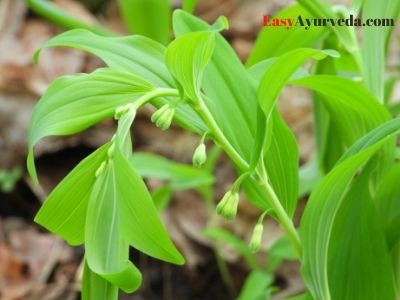
Table of Contents
Vernacular Names
English Name – Whorled solomon’s seal
Sanskrit Name – Meda
Hindi Name – Basuchidra, Devamani, Pandura, Shakakul, Seal, Vasuchhidra
Urdu Name – Nor-e-Alam
Pahari Name – Salam mishri
Nepali Name – Keruwa, Khinraula
Pashto Name – Peramole
Kashmiri Name – Mishri, Mitha dodhu, Ra-mnye, Khol
Gilgati or Balti Name – Saat Ashee in
Chinese Name – Lun Ye Huang Jing
Medicinal Qualities
Taste (Rasa) – Sweet
Potency (Virya) – Cold
Qualities (Guna)
Guru – heavy to digest
Action (Karma) –
Vrishya – Aphrodiasiac
Sthanyavaham – increases breast milk
Brihmana – nourishes the body tissues
Shukrakrit – increases semen
Effect on Doshas
Balances aggravated Pitta and Vata dosha
Aggravates Kapha dosha
Read – Kakoli (Roscoea purpurea) Uses, Medicinal Qualities, Remedies, Research
Therapeutic Uses
Burning sensation
Pain (arti)
Cough
Tuberculosis (Rajayakshma)
Bronchitis
Fever
Emaciation (Kshaya)
Depletion of body tissues (Kshata kshaya)
Rheumatism
Piles
Wounds
Leucorrhoea
Part Used
Rhizome
Dosage
Rhizome powder – 2- 3 grams or as directed by the physician
Read – Kshirakakoli (Lilium polyphyllum) Uses, Medicinal Qualities, Research
Sanskrit Verses
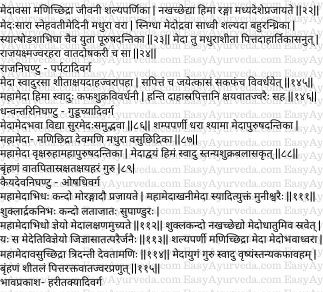
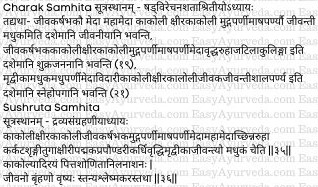
Remedies
Polygonatum verticillatum is used as folklore medicine. Its utility varies in different places
- In General debility, the plant root is used with milk and ghee. This recipe is practised in some parts of Gilgit. In other regions this plant is taken to cure flatulence.
- The roots of the plant are cut into small pieces and soaked in water overnight. Next morning, it is crushed in same water and consumed daily every morning. This remedy is used to treat Spermatorrhaea and piles.
- In leucorrhoea, root powder is mixed with water and taken daily.
- To treat wound, root paste of meda plant is applied externally on wound.
Read – Brimhaneeya Gana Herbs: Review, Benefits, Formulations
Nutritional Values
Polygonatum verticillatum contains moisture [(84.53 ± 4.69) g/100 g], protein [(16.20 ± 1.62) g/100 g], fat [(0.46 ± 0.06) g/100 g], fibre [(12.33 ± 0.57) g/100 g], carbohydrates [(17.07 ± 0.00) g/100 g], ash [(7.45 ± 0.79) g/100 g], energy value [(108.23 ± 9.73) Kcal/100 g]. The plant also possess micronutrient such as Phosphorus, Potassium, Sodium, Calcium, Magnesium, Iron, Copper and Manganese.
Pharmacological Activities
Polygonatum verticillatum possesses Antimalarial, Antipyretic, Anti-inflammatory, Anticonvulsant, Lipoxygenase, Urease Inhibition, Diuretic, Tracheorelaxant, Antidiarrheal, Antispasmodic, Antinociceptive, Antifungal, Antibacterial and Bronchodilator activities.(A)
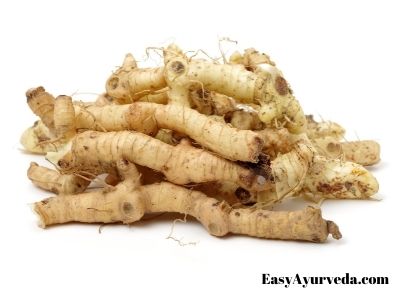
Botanical Description
Polygonatum verticillatum is a perennial rhizomatous herb with erect stem growing up to 2-4 feet in height. Leaves are arranged in whorls, sessile, Lanceolate/linear in shape. Flowers are white or pale yellow, tinged with green. Fruits berry, red and when matures it turns purple in color. Rhizomes are thick, white in color, sandy surface and shortly branched.
Description of rhizomes of Meda as per Bhavaprakasha Nighantu – They are white in color and secretes latex when pricked by nails, which resembles like fat tissue.
Distribution
Polygonatum verticillatum is mostly found in Himalayan regions, Kashmir, Sikkim, Southeast Tibet, West Asia, Europe, Russia, Afghanistan, Pakistan, Nepal, Bhutan and China.(B)
Substitutes
Satavari (Asparagus racemosus), Salam mishri (Eulophia campestris Wall.) are used as substitutes for Meda (Polygonatum verticillatum)
Chemical Constituents
Rhizome and aerial parts of Polygonatum verticillatum contain saponin, alkaloids, glycosides, phenols, flavonoids, sterols and tannins. In addition, rhizomes also has anthraquinones and terpenoids.
Classical Categorization
Bhavaprakasha Nighantu – Harithakyadi Varga
Kaiyadeva Nighantu – Oshadivarga
Dhanvantari Nighantu – Guduchyadi varga
Raja Nighantu – Parpataadi varga
Madanapala Nighantu – Abhayadi varga
Charaka Samhita – Included Meda under Jeevaniyaani, Shukrajananani and Snehopagaani dashemaani.
Sushruta Samhita – Included meda under Kakolyaadi ghana.
Research
Antinociceptive activity – A study that conducted with a aim to establish the pharmacological rationale for the traditional use of the Polygonatum verticillatum rhizomes in painful conditions and plant as a diuretic, has substantiated the folklore use of this plant as an analgesic.
Tracheorelaxant, Anti-inflammatory activities – A study was done to describe the tracheorelaxant and anti-inflammatory activity of Polygonatum verticillatum has proved the significant effect of Polygonatum verticillatum as tracheorelaxant through a Ca2+ channel blockade mechanism and anti-inflammatory activity.
Aphrodisiac Activity – A study conducted on Aphrodisiac properties of Polygonatum verticillatum leaf extract have proved the significant aphrodisiac effect of leaf extract of Polygonatum verticillatum.
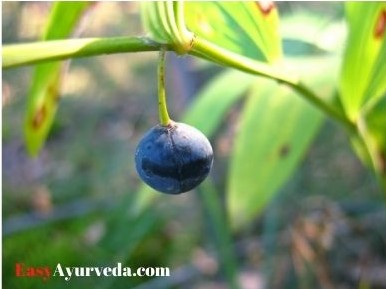
Formulations
Chyavanprash
Dasamoolarishtam
Dhaanwantharam mezhukupaakam – Used to treat vata diseases, paralysis, tissue depletion, pediatric problems etc.
Bruhath Chandanaadi Thailam
Amruth jeevan rasayan – Used in fatigue, low immunity etc
Brihat ashwagandha Ghrita – Used in oligospermia, infertility etc
Madhuyashtyadi taila – Best used in pitta related diseases such as fever and burning sensation
Shatavaryadi ghrita
Brihat Chagaladya Ghrita – Used to treat all types of Vata diseases
Vasachandanadi taila
Dhanwantharam thailam – Widely used to treat spondylosis, arthritis and neuro muscular conditions
Mahanarayan oil – Used in arthritis, paralysis and other vata diseases
Kamdev Ghrita – Used as aphrodisiac, rejuvenative, improves sperm count,body strength and skin complexion.
Artilon Soft Gel – Used in osteoarthritis
Dhanwantharam Kashayam – Used in post natal care of mother
Shiva gutika – Used in liver and spleen disorders
Prasoothika Kahayam – Used after delivery for restoring health
Guduchyadi taila – Used gout, itching in the scalp and headache
Baladhatryadi thailam – Best used in eye diseases
Classical Categorization
Bhavaprakasha Nighantu – Haritakyaadi varga
Kaiyadeva Nighantu – Oshadi varga
Dhanvantari Nighantu – Guduchyaadi varga
Raja Nighantu – Parpatadi varga
Madanapala Nighantu – Abhayadi varga
Charaka Samhita – Included Meda under Jeevaniyaani, Shukrajananani and Snehopagaani dashemaani.
Sushruta Samhita – Included Meda herb under Kakolyaadi ghana.
Read – Shukrajanana Gana: Herbs To Improve Semen, Sperm: Review, Formulations
Scientific Classification
Kingdom – Plantae
Division – Tracheophyta
Class – Liliopsida
Order – Liliales
Family – Liliaceae
Genus – Polygonatum
Species – verticillatum
Read more
Sanskrit Synonyms
Vasa, Manichidra, Jivani, Shalyaparnika,
Nakhachedya, Hima, Ranga, Madhyadesha,
Medah, Sara, Snehavati, Medini,
Madhura, Vara, Snigdha, Medodrava, Sadhvi, Shalyada, Bahurandrika
Dharaapi, Medabava, Vidhya, Surameda, Shreshta, Surameda, Samudbhava, Shyama,
Mahapurushadantika
Click here to consult Dr Renita D’Souza










